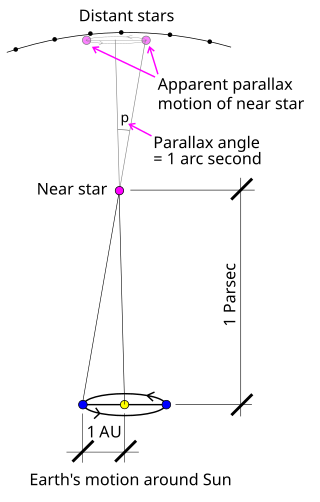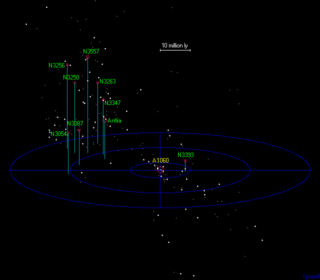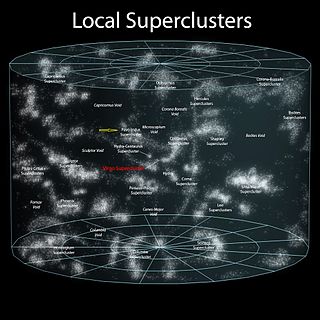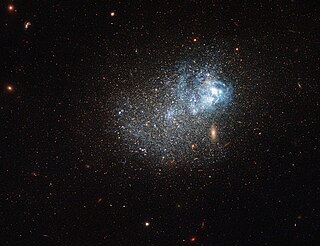Related Research Articles

A galaxy is a system of stars, stellar remnants, interstellar gas, dust, and dark matter bound together by gravity. The word is derived from the Greek galaxias (γαλαξίας), literally 'milky', a reference to the Milky Way galaxy that contains the Solar System. Galaxies, averaging an estimated 100 million stars, range in size from dwarfs with less than a thousand stars, to the largest galaxies known – supergiants with one hundred trillion stars, each orbiting its galaxy's center of mass. Most of the mass in a typical galaxy is in the form of dark matter, with only a few percent of that mass visible in the form of stars and nebulae. Supermassive black holes are a common feature at the centres of galaxies.

The Local Group is the galaxy group that includes the Milky Way, where Earth is located. It has a total diameter of roughly 3 megaparsecs (10 million light-years; 9×1019 kilometres), and a total mass of the order of 2×1012 solar masses (4×1042 kg). It consists of two collections of galaxies in a "dumbbell" shape; the Milky Way and its satellites form one lobe, and the Andromeda Galaxy and its satellites constitute the other. The two collections are separated by about 800 kiloparsecs (3×106 ly; 2×1019 km) and are moving toward one another with a velocity of 123 km/s. The group itself is a part of the larger Virgo Supercluster, which may be a part of the Laniakea Supercluster. The exact number of galaxies in the Local Group is unknown as some are occluded by the Milky Way; however, at least 80 members are known, most of which are dwarf galaxies.

The parsec is a unit of length used to measure the large distances to astronomical objects outside the Solar System, approximately equal to 3.26 light-years or 206,265 astronomical units (AU), i.e. 30.9 trillion kilometres. The parsec unit is obtained by the use of parallax and trigonometry, and is defined as the distance at which 1 AU subtends an angle of one arcsecond. The nearest star, Proxima Centauri, is about 1.3 parsecs from the Sun: from that distance, the gap between the Earth and the Sun spans slightly less than 1/3600 of one degree of view. Most stars visible to the naked eye are within a few hundred parsecs of the Sun, with the most distant at a few thousand parsecs, and the Andromeda Galaxy at over 700,000 parsecs.

A supercluster is a large group of smaller galaxy clusters or galaxy groups; they are among the largest known structures in the universe. The Milky Way is part of the Local Group galaxy group, which in turn is part of the Virgo Supercluster, which is part of the Laniakea Supercluster, which is part of the Pisces–Cetus Supercluster Complex. The large size and low density of superclusters means that they, unlike clusters, expand with the Hubble expansion. The number of superclusters in the observable universe is estimated to be 10 million.

The Virgo Supercluster or the Local Supercluster was a formerly defined supercluster containing the Virgo Cluster and Local Group, which itself contains the Milky Way and Andromeda galaxies, as well as others. At least 100 galaxy groups and clusters are located within its diameter of 33 megaparsecs. The Virgo SC is one of about 10 million superclusters in the observable universe and is in the Pisces–Cetus Supercluster Complex, a galaxy filament.

The Hydra–Centaurus Supercluster, or the Hydra and Centaurus Superclusters, was a previously defined supercluster in two parts, which prior to the identification of Laniakea Supercluster in 2014 is the closest neighbour of the former Virgo Supercluster. Its center is located about 39 Mpc (127 Mly) away.
The Northern Local Supervoid is a region of space devoid of rich clusters of galaxies, known as a void. It is the closest supervoid and is located between the Virgo (Local), Coma and Hercules superclusters. On the sky, it is located between Boötes, Virgo, and Serpens Caput constellations. It contains a few small galaxies and galaxy clusters, but is mostly empty. The faint galaxies within this void divide the region into smaller voids, which are 3–10 times smaller than the supervoid. The center is located 61 Mpc (199 Mly) away at approximately and it is 104 Mpc (339 Mly) in diameter across its narrowest width.

The Pavo–Indus Supercluster is a neighboring supercluster located about 60–70 Mpc (196–228 Mly) away in the constellations of Pavo, Indus, and Telescopium. The supercluster contains three main clusters, Abell 3656, Abell 3698, and Abell 3742.

Knowledge of the location of Earth has been shaped by 400 years of telescopic observations, and has expanded radically since the start of the 20th century. Initially, Earth was believed to be the center of the Universe, which consisted only of those planets visible with the naked eye and an outlying sphere of fixed stars. After the acceptance of the heliocentric model in the 17th century, observations by William Herschel and others showed that the Sun lay within a vast, disc-shaped galaxy of stars. By the 20th century, observations of spiral nebulae revealed that the Milky Way galaxy was one of billions in an expanding universe, grouped into clusters and superclusters. By the end of the 20th century, the overall structure of the visible universe was becoming clearer, with superclusters forming into a vast web of filaments and voids. Superclusters, filaments and voids are the largest coherent structures in the Universe that we can observe. At still larger scales the Universe becomes homogeneous, meaning that all its parts have on average the same density, composition and structure.

In cosmology, galaxy filaments are the largest known structures in the universe, consisting of walls of galactic superclusters. These massive, thread-like formations can commonly reach 50/h to 80/h Megaparsecs —with the largest found to date being the Hercules-Corona Borealis Great Wall at around 3 gigaparsecs (9.8 Gly) in length—and form the boundaries between voids. Due to the accelerating expansion of the universe, the individual clusters of gravitationally bound galaxies that make up galaxy filaments are moving away from each other at an accelerated rate; in the far future they will dissolve.

The Local Void is a vast, empty region of space, lying adjacent to the Local Group. Discovered by Brent Tully and Rick Fisher in 1987, the Local Void is now known to be composed of three separate sectors, separated by bridges of "wispy filaments". The precise extent of the void is unknown, but it is at least 45 Mpc across, and possibly 150 to 300 Mpc. The Local Void appears to have significantly fewer galaxies than expected from standard cosmology.

The Hercules Superclusters refers to a set of two nearby superclusters of galaxies.

Cosmic voids are vast spaces between filaments, which contain very few or no galaxies. Most galaxies are not located in voids, despite their size, due to most galaxies being gravitationally bound together, creating huge cosmic structures known as galaxy filaments. The cosmological evolution of the void regions differs drastically from the evolution of the Universe as a whole: there is a long stage when the curvature term dominates, which prevents the formation of galaxy clusters and massive galaxies. Hence, although even the emptiest regions of voids contain more than ~15% of the average matter density of the Universe, the voids look almost empty to an observer.

I Zwicky 36, often abbreviated to I Zw 36, is a galaxy in the constellation of Canes Venatici. It is located at a distance of about 5.8 megaparsecs from the Milky Way.

The dipole repeller is a center of effective repulsion in the large-scale flow of galaxies in the neighborhood of the Milky Way, first detected in 2017. It is thought to represent a large supervoid, the Dipole Repeller Void.
The KBC Void is an immense, comparatively empty region of space, named after astronomers Ryan Keenan, Amy Barger, and Lennox Cowie, who studied it in 2013. The existence of a local underdensity has been the subject of many pieces of literature and research articles.

The Local Volume is a collection of more than 500 galaxies located in an area of the observable universe near us, within a spherical region with a radius of 11 megaparsecs from Earth or up to a radial velocity of redshift of z < 0.002.

ESO 383-76 is an elongated, X-ray luminous supergiant elliptical galaxy, residing as the dominant, brightest cluster galaxy (BCG) of the Abell 3571 galaxy cluster, the sixth-brightest in the sky at X-ray wavelengths. It is located at the distance of 200.6 megaparsecs from Earth, and is possibly a member of the large Shapley Supercluster. With a diameter of about 540.89 kiloparsecs, it is one of the largest galaxies known.
References
- ↑ Einasto, M; Einasto, J.; Tago, E.; Dalton, G. B.; Andernach, H. (1994-07-15), "The Structure of the Universe Traced by Rich Clusters of Galaxies", Monthly Notices of the Royal Astronomical Society , 269 (2): 301–322, Bibcode:1994MNRAS.269..301E, doi: 10.1093/mnras/269.2.301